US President Biden has the opportunity to reverse the fortunes of the country’s ailing rail network and spark the second great railway revolution.
America’s railways are expected to see an uptick in investment and an improvement in services under the Biden administration. The new president is a known train enthusiast and has taken on the nickname of “Amtrak Joe” after the brand name of the national long-distance rail operator.
During the presidential campaign, Joe Biden called for ‘sparking the second great railroad revolution’ pledging to ‘make sure that America has the cleanest, safest, and fastest rail system in the world – for both passengers and freight’.
Biden is a long-term advocate of using trains as a sustainable alternative to roads and aviation and plans to make it a key component of his net-zero economy pledge.
He has previously claimed that he will modernise and upgrade passenger rail throughout the country, with a focus on constructing new high-speed tracks and faster connections between metropolitan areas. This would also help create more jobs in the manufacturing and infrastructure sectors.
The country’s railway network is widely accepted as being inefficient, particularly passenger rail, which has reeled under the strain of reduced traffic, long-existing inefficiencies and chronic underfunding.
How well do you really know your competitors?
Access the most comprehensive Company Profiles on the market, powered by GlobalData. Save hours of research. Gain competitive edge.

Thank you!
Your download email will arrive shortly
Not ready to buy yet? Download a free sample
We are confident about the unique quality of our Company Profiles. However, we want you to make the most beneficial decision for your business, so we offer a free sample that you can download by submitting the below form
By GlobalDataThe rail sector has struggled under the Trump administration
According to MarketLine, the US passenger rail sector had total revenues of $25.8bn in 2019, representing a compound annual rate of change (CARC) of -0.1% between 2015 and 2019. Decline in recent years has been caused by revenues failing to keep up with costs, which has caused leading companies to consistently register losses. Budget cuts have also been an issue.
In March 2017, the Trump administration released the budget highlights for the upcoming fiscal year, cutting funding to the Department of Transportation (DoT) down to $16.3bn, which was 13% less compared to previous years.
The state of California decided on 21 May to sue the DoT, after the government decided to revoke its $929m in funding from the California High-Speed Rail Authority (CHSRA), which is in charge of developing a high-speed train connecting San Francisco to Los Angeles.
During the Trump administration, the only significant rail development was Brightline in Florida, connecting Miami with Fort Lauderdale and West Palm Beach; it is being extended to Orlando.
Covid-19 pandemic has exacerbated issues facing the sector
In March 2020, it was announced that Metropolitan Transportation Authority was seeking a $4bn federal bailout as the coronavirus pandemic triggered an extraordinary free fall in ridership and left transit officials facing the worst economic crisis in decades.
Amtrak, which received $1bn in emergency funding in April 2020 from Congress, said it expects to lose at least $700m in operating earnings in 2020 due to the effects of the pandemic. In September 2020, Amtrak decided to furlough more than 2,000 workers due to plummeting demand and in October warned that without federal funding it would be forced to reduce services with a loss of an additional 2,400 jobs.
The revitalisation of the railway network will be a difficult and lengthy journey but under the new administration, the future looks somewhat brighter.







Related Company Profiles
BRIGHTLINE, L.P.
Metropolitan Transportation Authority
DOT GmbH
MarketLine